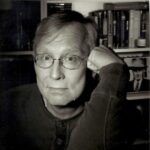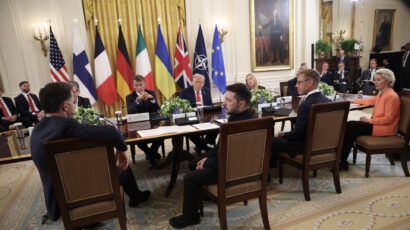Atomic testament: Yoshito Matsushige and the first photos of Hiroshima’s nuclear toll
By David A. Wargowski | August 6, 2025
 Photojournalist Yoshito Matsushige, in front of the first image he took at Miyuki-bashi Bridge, a little over two hours after the United States dropped a nuclear bomb on Hiroshima. He took a total of 5 images, the only recorded evidence of that day that changed history. (Photo by John van Hasselt/Corbis via Getty Images)
Photojournalist Yoshito Matsushige, in front of the first image he took at Miyuki-bashi Bridge, a little over two hours after the United States dropped a nuclear bomb on Hiroshima. He took a total of 5 images, the only recorded evidence of that day that changed history. (Photo by John van Hasselt/Corbis via Getty Images)
In the late morning hours of August 6, 1945, a single shutter clicked in Hiroshima and recorded what no camera had ever captured before, and none has again: the immediate, lived aftermath of a city annihilated by nuclear weapons.
Equipped with one camera and two rolls of film, totaling just 24 possible exposures, Yoshito Matsushige, then a 32-year-old photojournalist, ventured toward the city that morning to report for duty. Fires blocked access to his office, so he turned back and reached Miyuki Bridge (about 2,300 meters from ground zero) where he encountered the unfathomable: charred schoolgirls, civilians with melted skin, and a landscape of human agony.
He could barely bring himself to document it. But his five surviving images—the only known photographs of Hiroshima’s destruction on the day of the bombing itself—are among the most harrowing visual records of the nuclear age.
A Witness with a Camera
Born in 1913 in Kure, Hiroshima Prefecture, Matsushige joined the Geibinichinichi Newspaper Corporation in 1941, and later worked for the Chugoku Shimbun after a wartime media consolidation. He also held a secondary role as a military press officer at the Chugoku Regional Army Headquarters.
On the morning of August 6, he was at home in Midori-cho, about 1.7 miles from the bomb’s hypocenter, just outside the radius of complete destruction. Though his home was damaged, Matsushige survived relatively uninjured.
Over the next 10 hours, emotionally paralyzed by the suffering and fearful of provoking survivors’ ire, he pressed his camera shutter just seven times. Lacking clean water and darkroom resources, Matsushige was unable to develop the film immediately. He waited 20 days before processing the images outdoors, at night, using a radioactive stream to rinse them. Two of the exposures were ruined.
The other five stark and unflinching photographs—presented here with Matsushige’s own recollections and other early images included in his 1996 book, Atomic Bomb Photo Testament—are now considered iconic evidence of the Hiroshima bombing and the unimaginable consequences of nuclear war.
From Censorship to Global Impact
In the aftermath of the bombing, US occupation authorities confiscated most newspaper and film documentation of the Hiroshima and Nagasaki bombings. Matsushige’s negatives survived the sweep, but the images were little seen until after the occupation ended in 1952.
That year, on the seventh anniversary of the bombing, the Japanese magazine Asahi Gurafu published Matsushige’s photographs in a special issue titled “First Exposé of A-Bomb Damage.” The issue struck a nerve, selling out within hours and requiring four reprints. Total circulation reached approximately 700,000 copies. That same month, Life magazine published two of his images under the headline “When Atom Bomb Struck – Uncensored.” The photographs, once withheld from the world, quickly became central to the global understanding of what had happened in Hiroshima.

From Journalist to Peace Activist
After retiring from Chugoku Shimbun in 1969, Matsushige dedicated the remainder of his life to peace advocacy. He authored multiple photo essays and books chronicling the bombing’s aftermath, and spoke both in Japan and internationally, including before the United Nations General Assembly. In 1978, he helped found the Association of Photographers of the Atomic Bomb Destruction of Hiroshima, a group that included other Hiroshima photographers and the families of those who had died since 1945. Matsushige was also a member of the Atomic Photographers Guild. He remained active in preserving the photographic legacy of that day until his death in 2005 at the age of 92.


Matsushige’s five photographs are not simply historical records. They are moral documents etched in celluloid and seared into collective memory. They continue to confront us with the real human cost of nuclear warfare. Through his restraint, pain, and perseverance, Matsushige ensured that Hiroshima’s suffering would never be forgotten.
“Those of us who experienced all these hardships, we hope that such suffering will never be experienced again by our children and our grandchildren. Not only our children and grandchildren, but all future generations should not have to go through this tragedy. That is why I want young people to listen to our testimonies and to choose the right path, the path which leads to peace.”
The images captured by Matsushige and the other photographers who witnessed the bombings of Hiroshima and Nagasaki remain indispensable tools in the global struggle for nuclear disarmament. In capturing, with quiet courage, what should never happen again, Matsushige and his fellow photographers left behind something stronger than words, a visual testament to the necessity of peace.
Together, we make the world safer.
The Bulletin elevates expert voices above the noise. But as an independent nonprofit organization, our operations depend on the support of readers like you. Help us continue to deliver quality journalism that holds leaders accountable. Your support of our work at any level is important. In return, we promise our coverage will be understandable, influential, vigilant, solution-oriented, and fair-minded. Together we can make a difference.
Keywords: Hiroshima, Japan, United States, World War II, Yoshito Matsushige, nuclear war, photography
Topics: Nuclear Risk, Nuclear Weapons


















heartbreaking.
I wish this had been presented as a normal web page. I had to plow through source code to find the links to load the individual images. Please make it functional and accessible and not “fancy.”
This is a great article, and beautifully presented. I can truly feel the impact of these great photographs.
Thank you for sharing these powerful and haunting images from the first use of a nuclear weapon on fellow human beings. May we see the abolition of all of these horrific weapons of mass destruction.
Many thanks for this important document.
Good article but presentation a disaster, very difficult to view/scroll, and it does not print (pdf, ..)
Thank you for publishing these photographs, encouraging future generations to take heed and never repeat the atrocities of the past. May peace endure for all humankind.